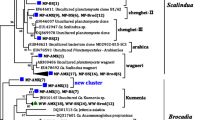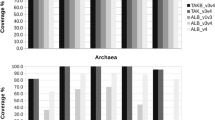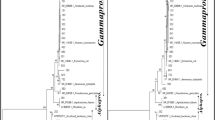Abstract
Autotrophic ammonia-oxidizing bacteria (AOB) are an essential component of nitrifying wastewater treatment systems. The molecular tools used in group-specific studies are mostly based on the sequence of the 16S rRNA gene, but they have not proved to be fully specific. In this study, the sequence of the FISH probe Nso1225R was used as a reverse primer in order to analyze the AOB composition of several environmental samples by denaturing gradient gel electrophoresis (DGGE). For this purpose, samples from several environments, including aerated reactors, water treatment wetlands, and pilot plants, both aerobic and anaerobic, were analyzed. PCR fragments displayed a DGGE pattern consisting of bands melting between 30 and 40% denaturant, and a series of unresolved bands above 45%, mostly corresponding to AOB and β-non-AOB, respectively. This second set of bands corresponded to environments subjected to severe oxygen restrictions. AOB sequences showed similarity percentages higher than 92% with those of known β-AOB. Nso1225R, therefore, proved to be a good molecular phylogenetic marker for AOB samples from well-aerated systems, showing a higher specificity than the group-specific primers used previously.


Similar content being viewed by others
Abbreviations
- AOB :
-
Ammonia-oxidizing bacteria
- DGGE :
-
Denaturing gradient gel electrophoresis
- MOB :
-
Methane-oxidizing bacteria
- Nc. :
-
Nitrosococcus
- Nm. :
-
Nitrosomonas
- Ns.:
-
Nitrosospira
References
Aakra A, Utåker JB, Nes IF (1999a) RFLP of rRNA genes and sequencing of the 16S-23S rDNA intergenic spacer region of ammonia-oxidizing bacteria: a phylogenetic approach. Int J Syst Bacteriol 49:123–130
Aakra A, Utåker JB, Nes IF, Bakken LR (1999b) An evaluated improvement of the extinction dilution method for isolation of ammonia-oxidizing bacteria. J Microbiol Methods 39:23–31
Aakra A, Utåker JB, Pömmerening-Roser A, Koops HP, Nes IF (2001) Detailed phylogeny of ammonia-oxidizing bacteria determined by rDNA sequences and DNA homology values. Int J Syst Evol Microbiol 51:2021–2030
Altschul SF, Madden TL, Schaffer AA, Zhang J, Zhang Z, Miller W, Lipman DJ (1997) Gapped BLAST and PSI-BLAST: a new generation of protein database search programs. Nucleic Acids Res 25:3389–3402
Bano N, Hollibaugh JT (2000) Diversity and distribution of DNA sequences with affinity to ammonia-oxidizing bacteria of the β-subdivision of the class Proteobacteria in the Arctic Ocean. Appl Environ Microbiol 66:1960–1969
Bothe H, Jost G, Schloter M, Ward BB, Witzel K (2000) Molecular analysis of ammonia oxidation and denitrification in natural environments. FEMS Microbiol Rev 24:673–690
Daims H, Ramsing NB, Schleifer KH, Wagner M (2001) Cultivation-independent, semiautomatic determination of absolute bacterial cell numbers in environmental samples by fluorescence in situ hybridization. Appl Environ Microbiol 67:5810–5818
Gieseke A, Purkhold U, Wagner M, Amann R, Schramm A (2001) Community structure and activity dynamics of nitrifying bacteria in a phosphate-removing biofilm. Appl Environ Microbiol 67:1351–1362
Hall TA (1999) BioEdit:a user-friendly biological sequence alignment editor and analysis program for Windows 95/98/NT. Nucleic Acids Symp Ser 41:95–98
Head IM, Hiorns WD, Embley TM, McCarthy AJ, Saunders JR (1993) The phylogeny of autotrophic ammonium-oxidizing bacteria as determined by analysis of 16S ribosomal RNA gene sequences. J Gen Microbiol 139:1147–1153
Heiko A, Schmidt KS, Vingron M, von Haeseler A (2000) TREE-PUZZLE. In: Strimmer K, von Haeseler A, Schmidt (eds) Theoretical bioinformatics, 5.0 edn. Deutsches Krebsforschungszentrum (DKFZ), Heidelberg, Germany
Hermansson A, Lindgren PE (2001) Quantification of ammonia-oxidizing bacteria in arable soil by real-time PCR. Appl Environ Microbiol 67:972–976
Hiorns WD, Hastings RC, Head IM, McCarthy AJ, Saunders JR, Pickup RW, Hall GH (1995) Amplification of 16S ribosomal RNA genes of autotrophic ammonia-oxidizing bacteria demonstrates the ubiquity of Nitrosospiras in the environment. Microbiology 141:2793–2800
Hovanec TA, DeLong EF (1996) Comparative analysis of nitrifying bacteria associated with freshwater and marine aquaria. Appl Environ Microbiol 62:2888–2896
Juretschko S, Timmermann G, Schmid M, Schleifer KH, Pömmerening-Roser A, Koops HP, Wagner M (1998) Combined molecular and conventional analyses of nitrifying bacterium diversity in activated sludge: Nitrosococcus mobilis and Nitrospira-like bacteria as dominant populations. Appl Environ Microbiol 64:3042–3051
Koops HP, Harms H (1985) Deoxyribonucleic acid homologies among 96 strains of ammonia-oxidizing bacteria. Arch Microbiol 141:214–218
Koops HP, Böttcher B, Möller UC, Pömmerening-Roser A, Stehr G (1991) Classification of eight new species of ammonia-oxidizing bacteria: Nitrosomonas communis sp. nov., Nitrosomonas ureae sp. nov., Nitrosomonas aestuarii sp. nov., Nitrosomonas marina sp. nov., Nitrosomonas nitrosa sp. nov., Nitrosomonas eutropha sp. nov., Nitrosomonas oligotropha sp. nov. and Nitrosomonas halophila sp. nov. J Gen Microbiol 137:1689–1699
Kowalchuk GA, Stephen JR, De Boer W, Prosser JI, Embley TM, Woldendorp JW (1997) Analysis of ammonia-oxidizing bacteria of the β-subdivision of the class Proteobacteria in coastal sand dunes by denaturing gradient gel electrophoresis and sequencing of PCR-amplified 16S ribosomal DNA fragments. Appl Environ Microbiol 63:1489–1497
Kowalchuk GA, Bodelier PL, Hans G, Heilig J, Stephen JR, J. LH (1998) Community analysis of ammonia-oxidizing bacteria, in relation to oxygen availability in soils and root-oxygenated sediments, using PCR, DGGE and oligonucleotide probe hybridization. FEMS Microbiol Ecol 27:339–350
Kowalchuk GA, Stienstra AW, Heilig GH, Stephen JR, Woldendorp JW (2000) Molecular analysis of ammonia-oxidizing bacteria in soil of successional grasslands of the Drentsche A (The Netherlands). FEMS Microbiol Ecol 31:207–215
Kumar S, Tamura K, Jakobsen IB, Nei M (2001) MEGA2: Molecular evolutionary genetics analysis software, edn 2.1. Arizona State University, Tempe, Arizona
Lane DJ (1991) 16S/23S rRNA sequencing. In: Goodfellows Sa (ed) Nucleic acid techniques in bacterial systematics. Wiley, Chichester, pp 177–204
Matulewich VA, Strom PF, Finstein MS (1975) Length of incubation for enumerating nitrifying bacteria present in various environments. Appl. Microbiol. 29:265–268
McCaig AE, Embley TM, Prosser JI (1994) Molecular analysis of enrichment cultures of marine ammonia oxidizers. FEMS Microbiol Lett 120:363–367
McCaig AE, Phillips CJ, Stephen JR, Kowalchuk GA, Harvey SM, Herbert RA, Embley TM, Prosser JI (1999) Nitrogen cycling and community structure of proteobacterial β-subgroup ammonia-oxidizing bacteria within polluted marine fish farm sediments. Appl Environ Microbiol 65:213–220
Mobarry BK, Wagner M, Urbain V, Rittmann BE, Stahl DA (1996) Phylogenetic probes for analyzing abundance and spatial organization of nitrifying bacteria. Appl Environ Microbiol 62:2156–2162
Mobarry BK, Wagner M, Urbain V, Rittmann BE, Stahl DA (1997) (Errata) Phylogenetic probes for analyzing abundance and spatial organization of nitrifying bacteria. Appl Environ Microbiol 63:815
Moore DD (1996) Purification and concentration of DNA from aqueous solutions. In: Ausubel FM, Brent R, Kingston RE, Moore DD, Seidman GJ, Smith JA, Struhl K (eds) Current protocols in molecular biology. Wiley, Chichester, pp 2.1.1–2.1.10
Muyzer G, de Waal EC, Uitterlinden AG (1993) Profiling of complex microbial populations by denaturing gradient gel electrophoresis analysis of polymerase chain reaction-amplified genes coding for 16S rRNA. Appl Environ Microbiol 59:695–700
Purkhold U, Pömmerening-Roser A, Juretschko S, Schmid MC, Koops HP, Wagner M (2000) Phylogeny of all recognized species of ammonia oxidizers based on comparative 16S rRNA and amoA sequence analysis: implications for molecular diversity surveys. Appl Environ Microbiol 66:5368–5382
Regan JM, Harrington GW, Noguera DR (2002) Ammonia- and nitrite-oxidizing bacterial communities in a pilot-scale chloraminated drinking water distribution system. Appl Environ Microbiol 68:73–81
Stackebrandt E, Rainey FA (1995) Partial and complete 16S rDNA sequences, their use in generation of 16S rDNA phylogenetic trees and their implications in molecular ecological studies. In: Molecular microbial ecology manual, vol. 3.1.1. Kluwer, The Netherlands, pp 1–17
Stephen JR, McCaig AE, Smith Z, Prosser JI, Embley TM (1996) Molecular diversity of soil and marine 16S rRNA gene sequences related to β-subgroup ammonia-oxidizing bacteria. Appl Environ Microbiol 62:4147–4154
Teske A, Alm E, Regan JM, Toze S, Rittmann BE, Stahl DA (1994) Evolutionary relationships among ammonia- and nitrite-oxidizing bacteria. J Bacteriol 176:6623–6630
Utåker JB, Nes IF (1998) A qualitative evaluation of the published oligonucleotides specific for the 16S rRNA gene sequences of the ammonia-oxidizing bacteria. Syst Appl Microbiol 21:72–88
Utåker JB, Bakken L, Jiang QQ, Nes IF (1995) Phylogenetic analysis of seven new isolates of ammonia-oxidizing bacteria based on 16S rRNA gene sequences. Syst Appl Microbiol 18:549–559
Voytek MA, Ward BB (1995) Detection of ammonium-oxidizing bacteria of the β-subclass of the class Proteobacteria in aquatic samples with the PCR. Appl Environ Microbiol 61:2811
Wagner M, Rath G, Amann R, Koops HP, Schleifer KH (1995) In situ identification of ammonium oxidizing bacteria. Syst Appl Microbiol 18:251–264
Ward BB, Martino DP, Diaz MC, Joye SB (2000) Analysis of ammonia-oxidizing bacteria from hypersaline Mono Lake, California, on the basis of 16S rRNA sequences. Appl Environ Microbiol 66:2873–2881
Acknowledgements
We thank Dr. Annette Bollmann (Netherlands Institute of Ecology, Center for Limnology, Maarsen) and Dr. Janne B. Utåker (Laboratory of Microbial Gene Technology, Dept. of Chemistry and Biotechnology Agricultural University of Norway) for kindly providing the genomic DNA of ammonia oxidizing bacteria. We would also like to thank the Laboratory of Chemical and Environmental Engineering from the University of Girona for providing the samples from the biodiscs, the aerobic and anaerobic reactors used in this work. This research was funded by the Spanish Ministry of Science and Technology (ref. CICYT REN2000 and BIO99-1014-CO2-01). Laia Calvó is the recipient of a fellowship from the Spanish Ministry of Science and Technology.
Author information
Authors and Affiliations
Corresponding author
Rights and permissions
About this article
Cite this article
Calvó, L., Vila, X., Abella, C.A. et al. Use of the ammonia-oxidizing bacterial-specific phylogenetic probe Nso1225 as a primer for fingerprint analysis of ammonia-oxidizer communities. Appl Microbiol Biotechnol 63, 715–721 (2004). https://doi.org/10.1007/s00253-003-1433-1
Received:
Revised:
Accepted:
Published:
Issue Date:
DOI: https://doi.org/10.1007/s00253-003-1433-1




